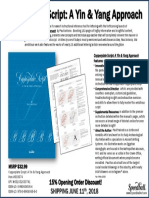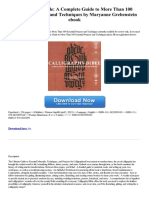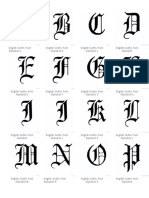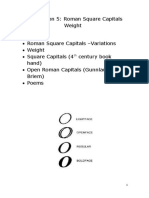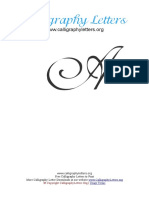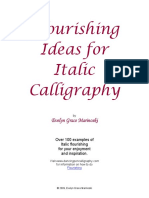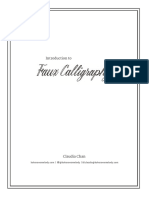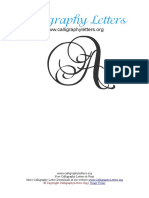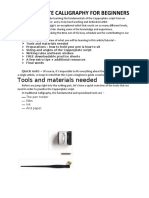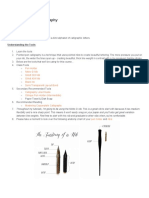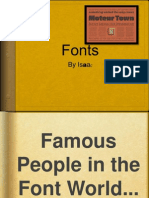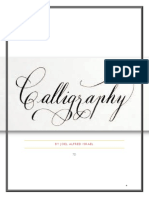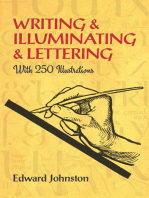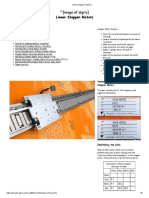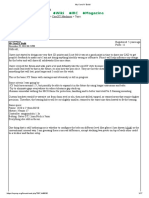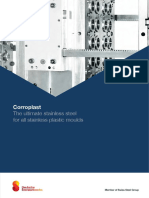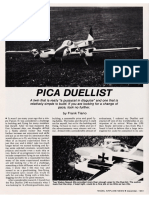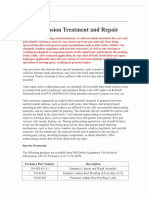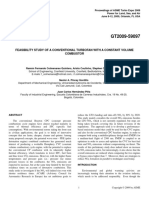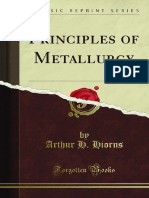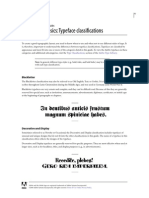Gothic Black Letter
Gothic Black Letter
Uploaded by
michaelguzziCopyright:
Available Formats
Gothic Black Letter
Gothic Black Letter
Uploaded by
michaelguzziCopyright
Available Formats
Share this document
Did you find this document useful?
Is this content inappropriate?
Copyright:
Available Formats
Gothic Black Letter
Gothic Black Letter
Uploaded by
michaelguzziCopyright:
Available Formats
Dranchenwald Kingdom University A.S.
XXXX
Introduction to Blackletter Calligraphy
Gothic Blackletter
Notes for a practical calligraphy class at Kingdom University AS XXXX.
Introduction
The Blackletter or Gothic script is a calligraphic hand widely used in western Europe from the twelfth to the sixteenth century. Its main advantage over its precursor, Carolingian, is that the letters are simple, faster to write and take up much less space. This was a major advantage as during this period the demand for books had greatly increased. The narrower Gothic script allowed more letters to be Detail from the Malmesbury Bible, 1407 written on the same page, thus minimising the amount of parchment required for each book. The original tendancy to do large illustrations and borders on each page was also curtailed, leading to illustrations often being limited to large initial capitals as shown in the Aberdeen Bestiary.
Pens
Many calligraphy pens and nibs are commercially available. For Blackletter you need a pen with a broad flat nib. If youre new to calligraphy or just want something thats easily available and good for basic practice, the Berol calligraphy felt tip pens are very useful and come in a number of widths. Art shops also often sell double-ended colour calligraphy felt tips with a different tip width at each end. If you want to do something very large and bold, square-tipped marker pens can also be used. For more formal pieces such as scrolls it is more usual to use either a specialist calligraphy fountain pen or a dip pen with a removable nib. Lettering created with these looks fabulous but the pens themselves often take a bit of getting used to. Pilot and Berol do ArtPens which are broad-nibbed fountain pens which are much easier to use than the more traditional dip pens. The pen should be held close to upright with the line of the nib about 30 from the horizontal. This gives the correct weight to the downstrokes and the sideways strokes.
Ruling up lines
It is much easier to maintain consistency between letters if you draw them between pencil lines. These guide lines are still visible on many mediaeval manuscripts. The separation of the lines is defined in terms of the width of the nib of the pen. Gothic blackletter miniscules (lower case Height for letters) use a height of four nib widths for Height for Height for numerals miniscules majuscules the body of the letter plus two pen widths each for ascenders and descenders. Majuscules (upper case letters) use a height of six nib widths for the body plus two nib widths for descenders. Numerals use a height of five pen widths. When drawing up the lines use a hard pencil so that it leaves only a faint line. These can be erased once the ink is dry.
Lady Freyds Thrfinnsdttir
Page 1
Dranchenwald Kingdom University A.S. XXXX
Introduction to Blackletter Calligraphy
Creating the letters
The three illustrations below show the individual letters in both miniscule and majuscule, together with numerals and punctuation. The grey lines show the order and direction of the strokes used to make up the letters. The most important stroke in Blackletter is the downstroke, as this forms the basis of most of the letters. It may either fill just the body of the letter or extend into the ascender or descender. Practice getting the line straight and the serifs equal before going on to the other parts of the letters. The large curves of the majuscules also take some practise to get the balance right. The maexcules are, in general, far more curved than the miniscules and therefore much wider. The letter S, in majuscule or miniscule, can be very difficult to get write, so dont be disheartened if it appears unbalanced!
Resources
Pre-lined practice papers (in MS Word format) for use with the Berol calligraphy pens are available at http://notendur.unak.is/not/nicolaw/stormbird/downloads/index.html. Wikipedia has an excellent article on Blackletter, its history and development. http://en.wikipedia.org/wiki/Blackletter The Aberdeen Bestiary is an excellent example of both Blackletter and illumination, and is available in its entirety on the web http://www.abdn.ac.uk/bestiary/
Gothic Blackletter Miniscules
Lady Freyds Thrfinnsdttir
Page 2
Dranchenwald Kingdom University A.S. XXXX
Introduction to Blackletter Calligraphy
Gothic Blackletter Majescules
Gothic Blackletter Numerals
Lady Freyds Thrfinnsdttir
Page 3
You might also like
- Copperplate Script: A Yin & Yang Approach: 15% Opening Order Discount!33% (3)Copperplate Script: A Yin & Yang Approach: 15% Opening Order Discount!1 page
- Free Downloads Mastering Calligraphy The Complete Guide To Hand Lettering20% (5)Free Downloads Mastering Calligraphy The Complete Guide To Hand Lettering4 pages
- Calligraphy Bible A Complete Guide To More Than 100 Essential Projects and Techniques PDFNo ratings yetCalligraphy Bible A Complete Guide To More Than 100 Essential Projects and Techniques PDF3 pages
- Calligraphy Letters: Free Calligraphy Letters To Print More Calligraphy Letter Downloads at Our Website68% (19)Calligraphy Letters: Free Calligraphy Letters To Print More Calligraphy Letter Downloads at Our Website26 pages
- Calligraphy: Try Your Hand at This Ageless Art100% (5)Calligraphy: Try Your Hand at This Ageless Art6 pages
- Gothic Lettering (Also "Blackletter", Old English Calligraphy, Etc)No ratings yetGothic Lettering (Also "Blackletter", Old English Calligraphy, Etc)1 page
- Art Class: Hand Lettering: A beginner’s guide to modern calligraphy, brushwork scripts, and blackboard letter artFrom EverandArt Class: Hand Lettering: A beginner’s guide to modern calligraphy, brushwork scripts, and blackboard letter artNo ratings yet
- Charlart Script Flourishing Worksheets Group 3100% (1)Charlart Script Flourishing Worksheets Group 315 pages
- Script in The Copperplate Style: Demystifying The Oblique PenholderNo ratings yetScript in The Copperplate Style: Demystifying The Oblique Penholder4 pages
- Rare Books On Calligraphy and PenmanshipNo ratings yetRare Books On Calligraphy and Penmanship2 pages
- (High Quality) Basics of Flourishing by Curious Medium100% (3)(High Quality) Basics of Flourishing by Curious Medium47 pages
- Monthly Updates: Earliest Forms of WritingNo ratings yetMonthly Updates: Earliest Forms of Writing1 page
- Flourishing Ideas For Italic Calligraphy PDFNo ratings yetFlourishing Ideas For Italic Calligraphy PDF3 pages
- Modern Calligraphy Practice Sheet LowercaseNo ratings yetModern Calligraphy Practice Sheet Lowercase2 pages
- OHsWC0uDQoeyZ5SyBNUz Copperplate Guidesheet PacketNo ratings yetOHsWC0uDQoeyZ5SyBNUz Copperplate Guidesheet Packet9 pages
- Calligraphy+Flourishing+Workshop by Telisa RoesseinArt Final100% (3)Calligraphy+Flourishing+Workshop by Telisa RoesseinArt Final13 pages
- The Art of Modern Calligraphy - Molly Jacques100% (1)The Art of Modern Calligraphy - Molly Jacques11 pages
- Bain Learningfromscript Designerscornerhsv 2017 PDF0% (1)Bain Learningfromscript Designerscornerhsv 2017 PDF10 pages
- Copperplate Basic Strokes Practice Sheets - Tri Shiba X Lettering Daily PDFNo ratings yetCopperplate Basic Strokes Practice Sheets - Tri Shiba X Lettering Daily PDF1 page
- Lupfer 1933 - Zaner's Fundamental Letter Forms A To Z - TE100% (1)Lupfer 1933 - Zaner's Fundamental Letter Forms A To Z - TE10 pages
- Design Guide to Learn Calligraphy: Fonts, Styles, Pens, Letters, & NumbersFrom EverandDesign Guide to Learn Calligraphy: Fonts, Styles, Pens, Letters, & Numbers2.5/5 (3)
- Corroplast: The Ultimate Stainless Steel For All Stainless Plastic MouldsNo ratings yetCorroplast: The Ultimate Stainless Steel For All Stainless Plastic Moulds6 pages
- 3mm Balsa False Leading Edge 6,5mm Balsa Leading EdgeNo ratings yet3mm Balsa False Leading Edge 6,5mm Balsa Leading Edge6 pages
- DPLV 2.1 Epoxy Primer: DP48LV (White) DP50LV (Gray) DP90LV (Black)No ratings yetDPLV 2.1 Epoxy Primer: DP48LV (White) DP50LV (Gray) DP90LV (Black)4 pages
- Feasibility Study of A Conventional TurbNo ratings yetFeasibility Study of A Conventional Turb18 pages
- Electrically Powered Propulsion Comparis PDFNo ratings yetElectrically Powered Propulsion Comparis PDF14 pages
- Blackletter Calligraphy: A Dramatic and Historic ScriptNo ratings yetBlackletter Calligraphy: A Dramatic and Historic Script4 pages
- [Ebooks PDF] download Printing History and Cultural Change: Fashioning the Modern English Text in Eighteenth-Century Britain Richard Wendorf full chapters100% (1)[Ebooks PDF] download Printing History and Cultural Change: Fashioning the Modern English Text in Eighteenth-Century Britain Richard Wendorf full chapters47 pages
- Latin Palaeography (Part I (I.5) Chapter 27 - Late Gothic Script. The Netherlands) Oxford pp. 468-481No ratings yetLatin Palaeography (Part I (I.5) Chapter 27 - Late Gothic Script. The Netherlands) Oxford pp. 468-48114 pages
- Download (Ebook) Lettering & Type: Creating Letters and Designing Typefaces by Bruce Willen, Nolen Strals ISBN 9781568987651, 156898765X ebook All Chapters PDF100% (3)Download (Ebook) Lettering & Type: Creating Letters and Designing Typefaces by Bruce Willen, Nolen Strals ISBN 9781568987651, 156898765X ebook All Chapters PDF81 pages
- David Harris - The Art of Calligraphy_ a Practical Guide to the Skills and Techniques-Dk Pub (1995)No ratings yetDavid Harris - The Art of Calligraphy_ a Practical Guide to the Skills and Techniques-Dk Pub (1995)132 pages
- Pengaruh Teknik Relaksasi Nafas Dalam Terhadap Penurunan Nyeri Pada Pasien FrakturNo ratings yetPengaruh Teknik Relaksasi Nafas Dalam Terhadap Penurunan Nyeri Pada Pasien Fraktur6 pages
- Typography: A Crash Course. Helmets Not IncludedNo ratings yetTypography: A Crash Course. Helmets Not Included39 pages
- Type and Typography - The Designers Type Book - Ben Rosen100% (1)Type and Typography - The Designers Type Book - Ben Rosen403 pages
